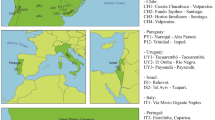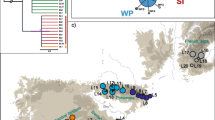Abstract
Hyphantria cunea (Drury) has colonized many countries outside its native range of North America and has become a model species for studies of the colonization and subsequent adaptation of agricultural pests. Molecular genetic analyses can clarify the origin and subsequent adaptations to non-native habitats. Using the mitochondrial COI gene, we examined the genetic relationships between invasive populations (China, Iran, Japan, and Korea) and native populations (i.e., the United States). The Jilin (China) and Guilan (Iran) populations showed nine previously unknown haplotypes that differed from those found in the south–central United States, suggesting multiple colonization events and different regions of invasion. A dominant mtDNA haplotype in populations in the United States was shared by all of the populations investigated, suggesting that H. cunea with that haplotype have successfully colonized China, Iran, Japan, and Korea.



Similar content being viewed by others
References
Ajamhassani M, Sendi J, Farsi M, Zibaee A (2012) Purification and characterization of phenoloxidase from the hemolymph of Hyphantria cunea (Lepidoptera: Arctiidae). Invert Surv J 9:64–71
Armstrong K, Ball S (2005) DNA barcodes for biosecurity: invasive species identification. Philos Trans R Soc Lond B Biol Sci 360:1813–1823. doi:10.1098/rstb.2005.1713
Ball SL, Armstrong KF (2006) DNA barcodes for insect pest identification: a test case with tussock moths (Lepidoptera: Lymantriidae). Can J Forest Res 36:337–350. doi:10.1139/x05-276
Boubou A, Migeon A, Roderick GK, Navajas M (2011) Recent emergence and worldwide spread of the red tomato spider mite, Tetranychus evansi: genetic variation and multiple cryptic invasions. Biol Invasions 13:81–92. doi:10.1007/s10530-010-9791-y
Byers JE (2000) Competition between two estuarine snails: implications for invasions of exotic species. Ecology 81:1225–1239. doi:10.1890/0012-9658(2000)081[1225:CBTESI]2.0.CO;2
Cini A, Ioriatti C, Anfora G (2012) A review of the invasion of Drosophila suzukii in Europe and a draft research agenda for integrated pest management. B Insectol 65:149–160
Clement M, Posada D, Crandall KA (2000) TCS: a computer program to estimate gene genealogies. Mol Ecol 9:1657–1659. doi:10.1046/j.1365-294x.2000.01020.x
Gomi T (1997) Geographic variation in critical photoperiod for diapause induction and its temperature dependence in Hyphantria cunea Drury (Lepidoptera: Arctiidae). Oecologia 111:160–165. doi:10.1007/s004420050220
Gomi T, Takeda M (1996) Changes in life-history traits in the fall webworm within half a century of introduction to Japan. Funct Ecol. doi:10.2307/2390287
Gomi T, Muraji M, Takeda M (2004) Mitochondrial DNA analysis of the introduced fall webworm, showing its shift in life cycle in Japan. Entomol Sci 7:183–188. doi:10.1111/j.1479-8298.2004.00051.x
Gomi T, Nagasaka M, Fukuda T, Hagihara H (2007) Shifting of the life cycle and life-history traits of the fall webworm in relation to climate change. Entomol Exp Appl 125:179–184. doi:10.1111/j.1570-7458.2007.00616.x
Hall TA (1999) BioEdit: a user-friendly biological sequence alignment editor and analysis program for Windows 95/98/NT. Nucleic Acids Symp Ser 41:95–98
Havill NP, Montgomery ME, Yu G, Shiyake S, Caccone A (2006) Mitochondrial DNA from hemlock woolly adelgid (Hemiptera: Adelgidae) suggests cryptic speciation and pinpoints the source of the introduction to eastern North America. Anna Entomol Soc Am 99:195–203. doi:10.1603/0013-8746(2006)099[0195:MDFHWA]2.0.CO;2
Hidaka T (1977) Adaptation and speciation in the fall webworm. Kodansha, Tokyo
Johns R, Flaherty L, Carleton D, Edwards S, Morrison A, Owens E (2016) Population studies of tree-defoliating insects in Canada: a century in review. Can Entomol. doi:10.4039/tce.2015.69
Kean J, Kumarasinghe L (2007) Predicting the seasonal phenology of fall webworm (Hyphantria cunea) in New Zealand. N Z Plant Prot 60:279
Low VL, Adler PH, Takaoka H et al (2014) Mitochondrial DNA markers reveal high genetic diversity but low genetic differentiation in the black fly Simulium tani Takaoka and Davies along an elevational gradient in Malaysia. PLoS One 9:e100512. doi:10.1371/journal.pone.0100512
Marsico TD, Wallace LE, Ervin GN, Brooks CP, Mcclure JE, Welch ME (2011) Geographic patterns of genetic diversity from the native range of Cactoblastis cactorum (Berg) support the documented history of invasion and multiple introductions for invasive populations. Biol Invasions 13:857–868. doi:10.1007/s10530-010-9874-9
Nagoshi RN, Meagher RL, Flanders K, Gore J, Jackson R, Lopez J, Leonard BR (2008) Using haplotypes to monitor the migration of fall armyworm (Lepidoptera: Noctuidae) corn-strain populations from Texas and Florida. J Econ Entomol 101:742–749. doi:10.1603/0022-0493(2008)101[742:UHTMTM]2.0.CO;2
Oliver AD (1964) A behavioral study of two races of the fall webworm, Hyphantria cunea, (Lepidoptera: Arctiidae) in Louisiana. Ann Entomol Soc Am 57:192–194. doi:10.1093/aesa/57.2.192
Pimentel D, Lach L, Zuniga R, Morrison D (2000) Environmental and economic costs of nonindigenous species in the United States. Bioscience 50:53–65. doi:10.1641/0006-3568(2000)050[0053:EAECON]2.3.CO;2
Scheffer SJ, Grissell E (2003) Tracing the geographical origin of Megastigmus transvaalensis (Hymenoptera: Torymidae): an African wasp feeding on a South American plant in North America. Mol Ecol 12:415–421. doi:10.1046/j.1365-294X.2003.01725.x
Silva-Brandão KL, Santos TV, Cônsoli FL, Omoto C (2015) Genetic diversity and structure of Brazilian populations of Diatraea saccharalis (Lepidoptera: Crambidae): implications for pest management. J Econ Entomol 108:307–316. doi:10.1093/jee/tou040307-316
Simon C, Frati F, Beckenbach A, Crespi B, Liu H, Flook P (1994) Evolution, weighting, and phylogenetic utility of mitochondrial gene sequences and a compilation of conserved polymerase chain reaction primers. Ann entomol Soc Am 87:651–701. doi:10.1093/aesa/87.6.651
Stepien CA, Brown JE, Neilson ME, Tumeo MA (2005) Genetic diversity of invasive species in the Great Lakes versus their Eurasian source populations: insights for risk analysis. Risk Anal 25:1043–1060. doi:10.1111/j.1539-6924.2005.00655.X
Sullivan GT, Ozman-Sullivan SK (2012) Tachinid (Diptera) parasitoids of Hyphantria cunea (Lepidoptera: Arctiidae) in its native North America and in Europe and Asia—a literature review. Entomol Fennica 23:181–192
Szalay-Marzso L (1971) Biology and control of the fall webworm (Hyphantria cunea Drury) in the middle and east European countries. EPPO Bull 1:23–31. doi:10.1111/j.1365-2338.1971.tb02577.x
Tamura K, Peterson D, Peterson N, Stecher G, Nei M, Kumar S (2011) MEGA5: molecular evolutionary genetics analysis using maximum likelihood, evolutionary distance, and maximum parsimony methods. Mol Biol Evol 28:2731–2739. doi:10.1093/molbev/msr121 (Epub 2011 May 4)
Umeya K, Itô Y (1977) Invasion and establishment of a new insect pest in Japan. In: Hidaka T (ed) Adaptation and speciation in the fall webworm. Kodansha, Tokyo, pp 1–12
Vitousek PM, D’antonio CM, Loope LL, Rejmanek M, Westbrooks R (1997) Introduced species: a significant component of human-caused global change. N Z J Ecol 21:1–16
Yan C, Wang H (1984) Quarantine techniques for the fall webworm. For Pest Dis 4:23–24
Yan Z, Sun J, Don O, Zhang Z (2005) The red turpentine beetle, Dendroctonus valens LeConte (Scolytidae): an exotic invasive pest of pine in China. Biodivers Conserv 14:1735–1760. doi:10.1007/s10531-004-0697-9
Yang ZQ, Wei JR, Wang XY (2006) Mass rearing and augmentative releases of the native parasitoid Chouioia cunea for biological control of the introduced fall webworm Hyphantria cunea in China. Biocontrol 51:401–418. doi:10.1007/s10526-006-9010-z
Acknowledgments
We thank Chiyoko Yamashiro, Lijun Cao, Nobuko Tuno, Libin Ma, and Juan Shi for their kind help in sample collection. We also would like to express our appreciation to Drs. K.Sakamoto and K.Maeto for their general support and assistance in the lab. This research was supported by grants from JSPS Grant-in-Aid (No. 15K18809) to MT and China scholarship Council (CSC) to FY.
Author information
Authors and Affiliations
Corresponding author
Rights and permissions
About this article
Cite this article
Yang, F., Sendi, J.J., Johns, R.C. et al. Haplotype diversity of mtCOI in the fall webworm Hyphantria cunea (Lepidoptera: Arctiidae) in introduced regions in China, Iran, Japan, Korea, and its homeland, the United States. Appl Entomol Zool 52, 401–406 (2017). https://doi.org/10.1007/s13355-017-0491-2
Received:
Accepted:
Published:
Issue Date:
DOI: https://doi.org/10.1007/s13355-017-0491-2




